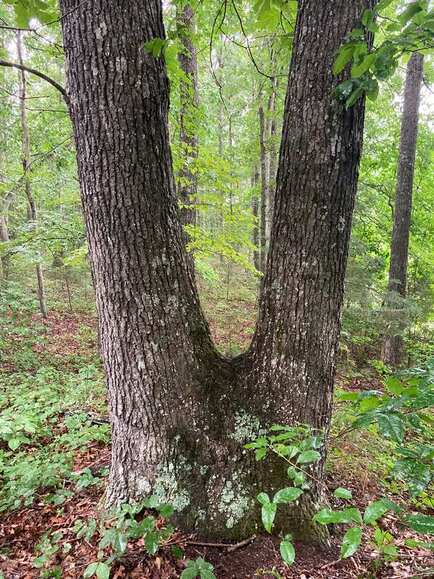Frequently Asked QuestionsPeople have lots of questions about green burial and we love to support conversations around it. Yes, it is legal in North Carolina.
Below are some answers to the questions most frequently asked. Please email us if you don't see the answer to your question. Q. What is green burial?
A. A green burial is one in which there is no embalming, no vaults, and everything used in the burial process is natural and bio-degradable. According to the Green Burial Council, the national certifying organization, green or natural burial is a way of caring for the dead with minimal environmental impact that furthers such legitimate ecological aims as the conservation of natural resources, reduction of carbon emissions, protection of worker health, and the restoration and/or preservation of native habitat. Q. What's the difference between green and natural burial? A. They are one and the same. The green burial movement which got its start in the US in the 1980s, is more recently using the expression natural burial to emphasize a return to nature. Q. What is conservation burial? A. Conservation burial is a cemetery classification designated by the Green Burial Council. Conservation burial cemeteries utilize green burial techniques and take that practice a step further in the protection of important natural and sensitive areas; deliberate conservation management of the property; placing limits on the burial density on the property; and furthermore, guaranteeing the preservation of the cemetery in perpetuity, with a conservation easement. Bluestem's conservation easement will be co-held by local land trusts Eno River Association and Triangle Land Conservancy. 
Q. Is conservation burial legal?
A. Yes. Bluestem Conservation Cemetery is a program of the nonprofit Bluestem Community. We follow all required State and Orange County, North Carolina, zoning, regulatory requirements, and cemetery laws, complete with the establishment of a perpetual care trust fund for the cemetery's future maintenance. Q. Who can be buried at Bluestem Conservation Cemetery? A. Burial at Bluestem is arranged and scheduled with staff and available to all. Q. When can I be buried at Bluestem Conservation Cemetery? A. Burial at Bluestem is scheduled with the Co-directors Heidi or Jeff. Q. How will Bluestem's graves be prepared and what will they look like? A. Burial sites are prepared by Bluestem staff. The burial depth for a grave is approximately 3.5 feet from the bottom of the grave to its surface. Staff use equipment to dig the grave prior to the service, and prior to the family and friends’ arrival at the cemetery. At the end of the memorial service, the soil that was removed from the grave is replaced in the grave either by the family, friends and/or staff and Bluestem volunteers. Flowers, wreaths made with biodegradable materials, and other natural materials may be added to the burial mound after it has been covered in pine straw. Over time, the soil settles into the grave and the surrounding area’s natural features blend into the site. The settling process varies depending on the type of burial vessel and location of the gravesite. A general approximation is anywhere from 1-2 years. Q. What are the burial choices at Bluestem Conservation Cemetery? A. Burial choice is offered in select areas of the restored open grasslands and native woodlands for both full natural body burial and ash burial. Bluestem does not currently allow for the scattering of remains. Q. Does Bluestem allow for pet burials? A. Yes. However, pet burials are currently only possible in an owner's paid plot. A future pet cemetery is envisioned, once fundraising is complete for that section of the property. Contact us if you wish to donate to the pet cemetery. Q. Are family and friends allowed to take part in the burial ceremony? A. Yes. Bluestem’s mission is to provide and care for the natural space that allows family and friends the opportunity to say a meaningful farewell. Staff encourage families to create a memorial service of their own design in keeping with the memory of their loved one. Participation in processing to the gravesite, lowering loved ones into the grave, and closing the grave is all supported. Bluestem staff are present to receive the body prior to the service, guide the burial process, and assist however the family wishes in lowering the body, closing the grave, and ensuring the safety of all participants. Q. How are the graves marked and located? A. Every gravesite is located and identified with an aluminum marker set in the grave, and stamped with the resident's name and dates. Cemetery grid coordinates are also recorded for every grave. GPS coordinates are further recorded for every burial plot, and provided to the family for independent visits to the gravesite. Families can additionally choose to honor loved ones with a simple flat grave stone provided by Bluestem staff. Bluestem’s cemetery records are maintained according to the highest standards of nonprofit management. Q. Who provides the funeral service?
A. Families have the choice of working with a funeral home, with a home funeral guide, or they can manage the pre-burial preparations on their own. Bluestem staff help support the planning of graveside services, which may be held at the time of interment. The service can include as much support or as little as the family chooses; however, it is overseen by Bluestem staff and volunteers, including both lowering the casket and closing the grave. Q. Are caskets required at Bluestem Conservation Cemetery? A. Bluestem permits any biodegradable burial product appropriate for green burial. Burial products can be unfinished wood caskets, wicker or woven caskets, cardboard caskets or cloth shrouds. A shroud must be a substantial piece of fabric used to wrap the body securely, and with handles for safe transportation. Contact us for Bluestem's Shrouding Guidelines. Q. Won't wild animals dig up my body? A. This is a common worry for people considering green burial. We can report that in the 40 years that green/natural/ conservation burial has been in operation in the US, there have been no cases of animals digging up bodies. Every grave at Bluestem is significantly deep enough and intentionally prepared to deter any wildlife curiosity. Staff additionally appraise gravesites for wildflower species enhancement, settling of the soil, and any unnatural leave behinds. Q. Is embalming required by law? A. Embalming is not required in any state. Embalming is a practice that was initially instituted to preserve a body for transportation from their place of death to their place of burial, made popular in the Civil War. The chemical used in embalming is formaldehyde, which the EPA has defined as a carcinogen, and has been proven to cause cancer in funeral staff. In keeping with green burial standards, Bluestem does not allow embalming, further limiting the potential for this chemical to leach into the land and subsurface water supply. Q. Does burying people without vaults and without embalming affect water quality? A. Conserved landscapes are a time-honored tool for protecting and improving water quality. Careful site selection has been made to ensure that Bluestem not only complies with, but exceeds all state and local health codes pertaining to water quality protection. Bluestem does not bury anywhere near its pond. Above its creeks, staff and volunteers have installed 100-foot water quality buffers (a measurement greater than Orange County requires) as further commitment to conservation. Maintenance within the buffer areas includes invasive management, habitat restoration, the repair or prevention of erosion, and installation and maintenance of bridges. Burial in the woodlands is only possible outside of the buffer areas. Q: What is the cemetery's density? Conservation cemeteries limit burial density to 300 plots per acre. As a point of contrast, average density in municipal cemeteries ranges between 1000-1200 plots/acre. Bluestem projects between 100-300 plots/acre. Restored natural areas will respect natural vegetation, provide improvements to adjacent waterways with stream buffers, and support greater biological diversity over time. Q. What happens to the body after burial? A. Upon burial, the decomposition of the human body proceeds rapidly. Bacteria and viruses typically die with the body or within days, and almost all become inert within a year. The earth’s soil and organisms facilitate the decomposition process and slow the exchange of bacteria and viruses, acting as a giant filter to prevent contamination. A conservation cemetery’s reduced burial density also limits the number of viable germs that can enter surface water or groundwater flow. International studies have demonstrated the low risk for germ transmission from green burial techniques. No known transmission of germs from a green burial ground have been recorded in the US. Q. How is green burial better for the environment? A. Green burial limits the introduction of non-biodegradable materials into the earth. Conventional practices for burial introduce metals, cement, finished wood products, synthetics, and formaldehyde into the subsurface soil layers. Over time these items, particularly when concentrated in compact density, have the potential to leach into nearby subsurface waters. Green burial's purpose is to encourage natural and rapid decomposition, which in turn, supports soil health, enhances plant diversity, and reduces the risk for nearby water contamination. Conservation burial further contributes to the ecological health and restoration of a property. Q. Is cremation a green alternative to conventional burial? A. Nationally, cremation is the most widely used burial choice. While burying cremated remains uses less land area than full body burial, the process of cremation requires over 30 gallons of fossil fuel per body, which is the equivalent vehicle emissions of a 600-mile trip. Additionally, the cremation process emits mercury, carbon and other toxins into the air. As cremation is a popular and increasing burial choice, Bluestem allows for the burial of cremated remains. All ash burials are amended with a neutralizing soil-like material prior to interment. Scattering of ashes is not currently available at Bluestem. Q. Is aquamation a green alternative to conventional burial? A. Aquamation is a new option for body disposition in the green burial movement. It is not, however, burial. Burial by definition is the interment of one's body. Because of the environmental impacts of cremation and aquamation, returning one's body to the earth simply and naturally is Bluestem's mission. For more information on aquamation we refer you to our colleagues in the green burial movement at Endswell, in Hillsborough, North Carolina. Q. What other options are available in the green burial movement? A. Another new form of decomposition developed by scientists in Washington State is natural organic reduction. With NOR, bodies are laid to rest in containers with plant material, and microbes break down the body, resulting in the formation of nutrient‑dense soil. A truck load of soil between 10-12 cubic yards is returned to the family for scattering. Bluestem does not currently support NOR. |
Bluestem |
Partner Sites |
Help build the vision!Bluestem is a 501(c)3 tax exempt organization, EIN 86-2188559. All donations are tax deductible.
|

